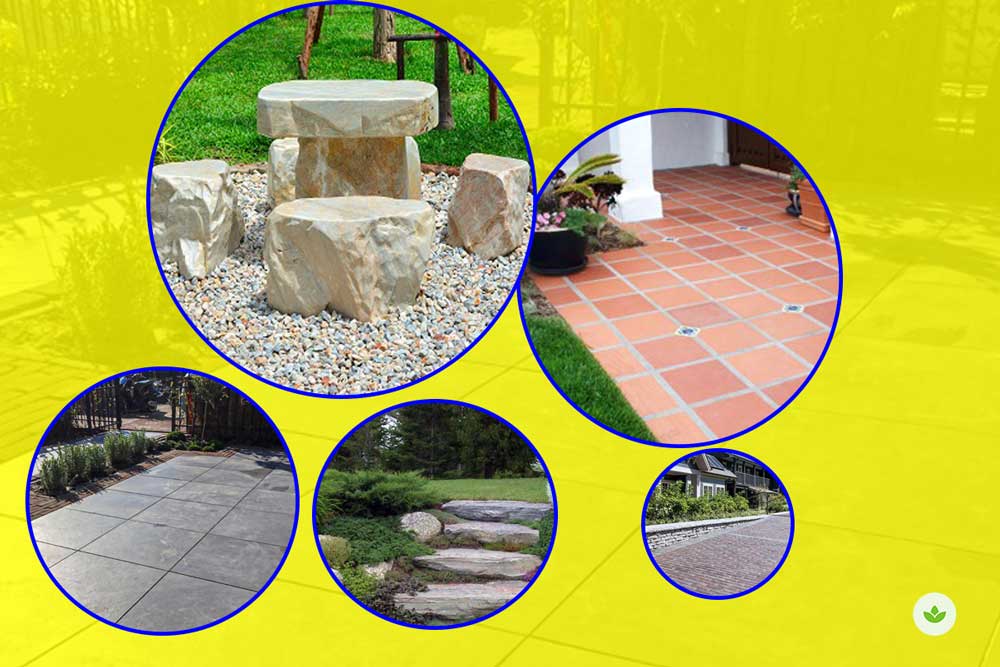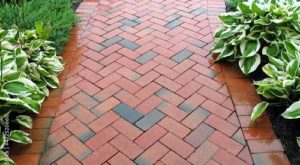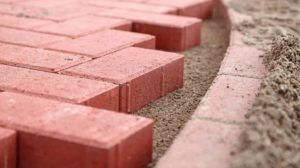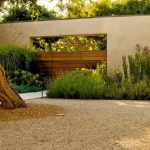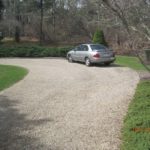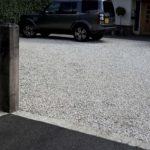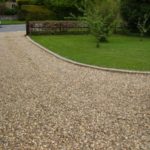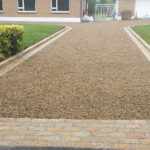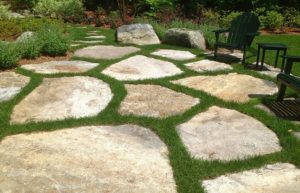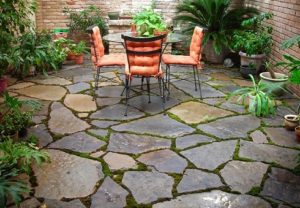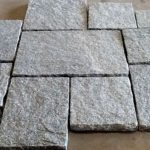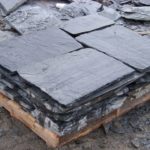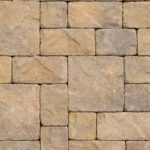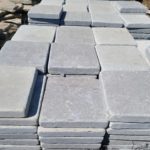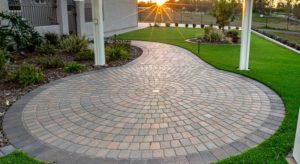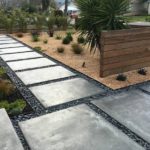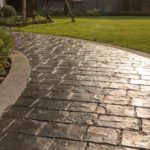Nothing impacts your garden’s character as much as paving materials. Each choice creates a distinct look, from the old-world charm of recycled bricks and cobbles to the contemporary appeal of concrete and cut stone. In addition, each material has its pros and cons as far as ease of installation, cost, durability, and climate considerations.
In the following sections, I give you an overview of the qualities of common paving materials, making it easy to compare contrast, and determine which one is best for your project.
1) Brick
We’ve all admired old brick paths, which blend so naturally with surrounding plants.
Brick features an array of warm colors, textures, and patterns. It is one of the most versatile paving materials. Whether you want;
- Picturesque: Maybe reclaimed brick from a former city street with plants creeping out of the joints
- Formal: Try crisp new brick in a precise, traditional pattern
- Something in between
But beware; many bricks are perfectly suitable for the wall of a house but unsuitable for paving. On the ground, they are attacked by water from all sides. When this water freezes, it can cause vulnerable bricks to flake or crumble.
Paving bricks are the best choice. They are pressed densely into molds by machine and baked longer than facing/cladding bricks, making them less absorbent and, as a result, better for outdoor flooring. Paving bricks normally have a lightly textured surface and are considerably thinner
If you live in an area where temperatures dip below freezing, purchase SW (severe weather) bricks.
- Brick walkway
- Brick pavers
- Brick driveway
How many bricks?
Though they come in various sizes and thicknesses, brick pavers are typically 3 inches thick, 4 inches wide, and 9 inches long.
Using that standard size (and allowing for joints between the bricks), it takes approximately five bricks to pave a square foot (.3 square m). Multiply the length of your floor by the width to determine total square feet or meters.
Cost:
The cost will depend on the quantity and style you choose. The 3 most common colors, red, tan, and gray- sell for the same price. The price of other styles and colors will vary.
You can get brick from;
- Brick suppliers
- Tile companies
- Home and building supply stores
Installing brick paving:
For a smooth brick surface, invest time in laying a firm foundation. If you are laying your floor on a flexible (as opposed to a concrete) foundation, you can’t do without edging; plan for that too.
Brick laying requires attention to detail, especially if you are laying intricate patterns.
Pros:
- Brick is easier to both quantify and lay.
- It provides a nice complement to brick houses and other structures. It also mixes well with other materials, from concrete to stone. It is especially effective and attractive edging.
- Brick is easier to clean
- If not mortared in, brick paving is relatively easy to remove
Cons:
- Brick can be difficult to match if your patio or terrace blends perfectly with your home’s exterior or an existing path or patio.
- Brick is susceptible to efflorescence (white streaks).
- Frost heaves and growing tree roots can cause brick paving to buckle
- Brick can crack under extreme weight
- Brick tends to grow mossy and slick in rainy climates,
- Brick floors can get especially hot underfoot in sunny climates.
2) Outdoor Tile
Outdoor paving tiles range from natural, unglazed terra-cotta squares to less traditional shapes with brightly colored glazes and intricate patterns. They are all available in a multitude of sizes.
You can use tiles to add regional flavor, color, and fun to your garden setting.
Be sure you use tiles designed specifically for outdoor use. The air and surface temperatures should be between 60 and 90 F (16 and 32 °C) when you’re installing tiles.
- Terra cotta terrace
- Terracotta entry
- Terra cotta paving
Quantity & Cost
To determine the amount of tiles, multiply the length of your floor by the width.
Tile is sold by the square foot or meter, with the price depending on the material and design you choose. Clay tile (such as terra-cotta) is less expensive than quarried tile.
You will find the best selection of garden tiles at centers that specialize in tile distribution. Some brick suppliers also sell tile. Be sure to specify vitreous or impervious tile with a non-skid surface for exterior use.
Pros:
- Very dense and highly resistant to scratching. If you want to make glazed tiles less slippery, add an abrasive coating.
- All except the lightest tiles resist dirt and staining
- Tiles offer vivid colors and customized designs
Cons:
- Tiles can’t withstand much load. Without a well-prepared concrete foundation, they are susceptible to cracking.
- Tiles are more labor-intensive to lay than working with many paving materials. You have to construct a concrete foundation, mortar the tiles in place, and grout between every joint.
- Custom-designed tiles can be expensive
3) Gravel & Pebbles
This eclectic paving material includes smooth water-washed pebbles dredged from riverbeds, bright angular chipping from larger rocks (crushed rock), and much in between.
Gravel and pebbles blend or contrast with virtually any surrounding plants and landscaping elements. It is versatile and can be used in a variety of settings from crisp, formal gardens to meditative rock gardens. Any gravel paving will have a much more sense of movement than fixed paving material.
Installation is moderately easy and much quicker. However, you should install edging around any gravel paving to help it stay in place.
- Decomposed-granite
- Crushed stone driveway
- Marble chips driveway
- Pea Gravel driveway
- River rock driveway
Quantity & cost
Many types of loose rock are sold in bags by cubic foot or meter. You can also purchase bulk quantities in cubic yards or tons in sand and gravel yards or quarries. You can cart it home in a truck or have it delivered at a fee.
To figure the amount of rock you need in cubic feet or meters, multiply the width and length of your pavement by how deep you want your rock. Divide cubic feet by 27 to convert to cubic yards.
You’ll get the best prices by buying in bulk. Special, decorative stone will cost you more than standard gravel.
Pros:
- Loose rock is one of the least expensive materials
- It drains well
- Conforms easily to curving layouts and gentle slopes
- Holds its shape if the ground underneath it heaves
- Acts as a mulch to surrounding plants
Cons:
- Larger stones (<4 inches) may be difficult to walk on
- Not the best choice for heavy traffic
- Tends to travel outside its borders
- Weeds can also pop up on loose rock paving
- Pure white rocks can discolor over time
4) Natural Stone
Natural stone pavers come in three major categories: fieldstone, flagstone, and cut stone.
- Fieldstone is rough, irregular, uncut stone collected from fields, streambeds, or old stone walls. For paving projects, you want smooth, flat fieldstones. Fieldstone is the material to use if you’re after a rustic, heavily textured floor.
- Flagstone is a quarried stone that is flat, thin, cut, or broken into irregular shapes, typically with jagged, angular edges. Flagstone, with its random shapes and aged surfaces, creates a similar effect but gives you a more even surface. Both lend themselves to imaginative patterns, with lots of irregular gaps in between the stones perfect for plantings.
- Cut stone (also called ashlar), is cut into uniform shapes, usually squares or rectangles ranging in size from about 1 square foot to 4 square feet. Cut stone will typically create a more elegant and formal-looking floor.
- Fieldstone
- Flagstone patio
- Cut stone
There are four main types of stone; the availability of each type varies by region.
- SEDIMENTARY STONE: Sandstone, limestone, and bluestone. Somewhat soft and easy to cut. They can feature intricate patterns and a textured surface that’s non-slippery. However, they are subject to staining and weathering because they are so porous.
- SLATE: A hard and durable stone, ranging in color from blue to gray to black. It’s thinly cut, so it’s best laid only on a concrete foundation.
- GRANITE: Very hard and durable. Colors range from white to pink to dark gray. It’s an expensive material, but useful for edging and surfacing.
- MARBLE: Expensive stone with stunning colors and patterns. It’s easy to cut but can make for a slippery paved surface.
- Marble paver
- Granite pavers
- Slate pavers
- Sandstone paver
- Limestone
- Bluestone
Installation
Laying fieldstone or flagstone is a bit like putting together a very large and very heavy jigsaw puzzle. Because each piece is different, you may find yourself spending a lot of time cutting and shaping your stones so they fit.
Cut stone will be slightly easier to dry lay, but mortaring it in place is a labor-intensive (and again, heavy) undertaking.
Quantity & Cost
Multiply the length of your floor by its width to determine the amount of stone you need in square feet or meters.
Fieldstone and flagstone are usually sold by the ton, but your figure in square feet or meters will give your supplier enough information to roughly calculate the amount you need.
Stone yards are a good source for all types of paving stones, and some tile companies sell cut stones, as well. Many offer delivery for a fee.
The size and thickness of the stone will affect the price. Some colors and types are also more expensive than others, with rare colors of cut stone being the most expensive of all. Also, you’ll pay a premium if you want to hand-pick your stones at a stone yard.
Pros:
- You can use fieldstone and flagstone on both level and gently sloping surfaces.
- Flagstone is easy to cut and shape.
- Cut stone creates a very smooth surface (ideal if your floor will be home to lots of outdoor furniture). And if it’s mortared in place, it becomes a nearly permanent surface.
Cons:
- Stones with irregular surfaces will collect puddles when it rains and can be difficult to walk on.
- Very smooth pavers such as marble or slate, become slick when wet
- Cut stone can be expensive
- Small dry-laid stones will be subject to frost heaves and cut stones can crack
5) Concrete pavers
Concrete slabs are still one of the most popular choices for gardens, perhaps because they are quick and easy to lay.
Concrete pavers lend themselves to nearly any look with their range of colors and textures. Some are excellent imitations of natural stone. Others come in artificial shapes from circles to hexagons or feature faux-stamped finishes that mimic materials such as brick, wood, or natural stone- they don’t have to look boring. The wedge-shaped ones are ideal for forming curves and circles.
The specially designed interlocking paver has an artificial but neat design. These are particularly suitable for driveways that will take reasonably heavy traffic or that are built on a slope.
- Concrete paver driveway
- Concrete paver patio
Installation
Because of their uniform size and shape, concrete pavers are somewhat easier to lay particularly for an amateur builder.
Laying non-interlocking blocks is quite similar to the detailed work of laying bricks. But mortaring them in place, if you choose to do so, is still labor-intensive
Again, investing the time and work in preparing a good foundation to start with is key.
Quantity & Cost
Multiply the length of your floor by its width to determine the amount you need. Paving blocks are slightly smaller than standard-size bricks, but you can still calculate quantity the same way you would for bricks, figuring on approximately five blocks to pave a square foot (.3 square m).
Concrete material and home and building suppliers are your best bet for purchasing pavers. Some distribution centers have demonstration areas, where laid sections of pavers make it easy to evaluate different colors and styles.
Pros:
- Long-lasting when well-laid
- Can withstand severe weather heavy loads without losing their color or structural integrity
- Half the cost of stone pavers
- Relatively easy to remove a section temporarily
Cons:
- Poor-quality pavers can create an unnatural look
- Wide expanses of interlocking pavers may have a monotonous effect
6) Poured concrete
Also known as “liquid stone,” concrete can be poured into any form imaginable. It can also be colored and texturized with everything from floats and brooms to imprints of leaves, stamped with patterns, and embedded with material from random shells to elaborate tile mosaics.
Though it lends itself easily to urban and contemporary settings, it can be adapted to many others.
Concrete floors are more time-consuming to create than any other. They also require more careful planning and more equipment.
- Concrete patio
- Poured concrete with expansion joints
- Poured concrete slabs
- Stamped concrete
- Concrete walkway
Quantity & Cost
You can use either premixed cement, which comes in bags (you simply add water), or bulk materials (Portland cement, sand, and aggregate) that you mix yourself in a rented mixer (or a wheelbarrow for small amounts). A bag of premix will typically tell you how much coverage it provides.
If you’re buying in bulk, your supplier can help you figure out how much you need. The amount may vary, depending on what region you live in.
Start with the standard formula: multiply the length by the width and depth of your floor and foundation area to determine the cubic feet or meters you need to cover (divide by 27 if you want to convert cubic feet to cubic yards). With cement, add 10 percent to your total for spillage or waste.
Home-and-building supply centers sell bagged cement. If you’re buying bulk materials and mixing them yourself, you can get the cement from a building supply store or a concrete materials supplier, and the sand and aggregate from a sand-and-gravel yard, all sold in cubic yards or by the ton. For larger jobs, it may be worthwhile to have a concrete supplier mix and deliver your cement.
Overall, concrete is one of the least expensive paving materials. Use pre-mixed bags only for small jobs (they’re too pricey for big ones). For other jobs, it may be a bit more expensive but worth the time savings to have a supplier deliver ready-mix cement. The cost will depend on your location, ease of access to your site, and the size of your order.
Pros:
- Most cost-effective paving materials
- Highly durable and long-lasting with little maintenance
- Design versatility
- Combines well with other materials to create interesting patterns and unique finishes
Cons:
- Concrete can look sterile if used in large sweeping sections
- It is more complicated to work with
- Once it is in, it is in. If you change your mind, you will need to break up the paving and start over
- Cracking concrete can be a problem in harsh winter climates or on sites with growing tree roots
- Extremes of heat and cold can cause damage during the concrete’s “curing.”
To Sum up
Take time to choose an appropriate paving material as there is such a bewildering variety of options.
You need to take into account the size of your garden and the area being paved. For a small area, small units of paving- like brick or pavers will probably look better than large paving slabs.
However, never be too rigid in your approach. Mixing materials can be very effective, and will probably give your garden a stronger sense of design. Don’t be afraid to mix clay pavers with concrete paving slabs. Even wood can be used to break up an area of paving that might otherwise look monotonous.
There you have it folk. Until next time!

